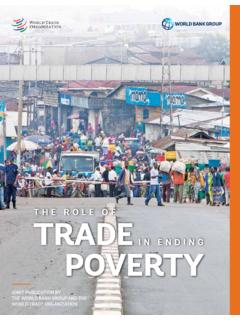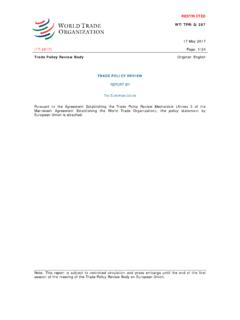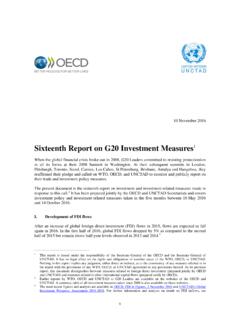Transcription of Regional Integration in Africa - World Trade Organization
1 Staff Working Paper ERSD-2011-14 Date: October 2011 World Trade Organization Economic Research and Statistics Division Regional Integration in Africa Trudi Hartzenberg Trade Law Centre for Southern Africa (tralac) Manuscript date: October 2011 Disclaimer: This is a working paper, and hence it represents research in progress. This paper represents the opinions of the author, and is the product of professional research. It is not meant to represent the position or opinions of the WTO or its Members, nor the official position of any staff members.
2 Any errors are the fault of the author. Copies of working papers can be requested from the divisional secretariat by writing to: Economic Research and Statistics Division, World Trade Organization , Rue de Lausanne 154, CH 1211 Geneva 21, Switzerland. Please request papers by number and title. 1 Regional Integration in Africa Trudi Hartzenberg Trade Law Centre for Southern Africa (tralac) Abstract: This paper examines the history of Regional Integration in Africa , what has motivated it, the different initiatives that African governments have pursued, the nature of the Integration process, and the current challenges.
3 Regional Integration is seen as a rational response to the difficulties faced by a continent with many small national markets and landlocked countries. As a result, African governments have concluded a very large number of Regional Integration arrangements, several of which have significant membership overlap. While characterized by ambitious targets, they have a dismally poor implementation record. Part of the problem may lie in the paradigm of linear market Integration , marked by stepwise Integration of goods, labour and capital markets, and eventually monetary and fiscal Integration .
4 This tends to focus on border measures such as the import tariff. However, supply-side constraints may be more important. A deeper Integration agenda that includes services, investment, competition policy and other behind-the-border issues can address the national-level supply-side constraints far more effectively than an agenda which focuses almost exclusively on border measures. Keywords: F15, O19 JEL Classifications: Regional Integration 2 1. Introduction There is much support from African governments for Regional Integration .
5 Indeed since independence they have embraced Regional Integration as an important component of their development strategies and concluded a very large number of Regional Integration arrangements (RIAs), several of which have significant membership overlap. There are however few success stories. African RIAs are generally ambitious schemes with unrealistic time frames towards deeper integration1 and in some cases even political union. African2 RIAs are usually neighbourhood arrangements.
6 Traditionally, the European Union was Africa s most important Trade , investment and development partner. Trade with the EU was governed by a series of Lom Conventions, which granted African countries (excluding South Africa ) unilateral preferential access to EU markets. The EU and African countries concluded the Cotonou Agreement which paved the way for the negotiation of World Trade Organisation (WTO) compatible Economic Partnership Agreements, in 2000. Various configurations of African countries have constituted negotiating groups; many of which however cut across existing neighbourhood Regional Integration arrangements, adding an additional layer of complexity to the Regional Integration process in Africa .
7 The protracted and difficult EPA negotiations reflect to some extent the difference between the African paradigm of Regional Integration and the EU s model of Regional Trade agreements, but also the challenges of African Regional Integration . The EPA negotiations revealed important gaps between political ambitions and economic reality in African Regional Integration . Debates about the African Integration agenda and indeed Africa s strategy for Integration into the global economy are emerging from these negotiations, which are still ongoing.
8 The African paradigm is that of linear market Integration , following stepwise Integration of goods, labour and capital markets, and eventually monetary and fiscal Integration . The starting point is usually a free Trade area, followed by a customs union, a common market, and then the Integration of monetary and fiscal matters to establish an economic union. The achievement of a political union, features as the ultimate objective in many African RIAs. This process is 1 Reference to deeper Integration in the context of African Regional Integration usually means progress from a free Trade area to a customs union and beyond to eventual political union.
9 This contrasts with the use of the term deeper Integration to refer to the inclusion of behind the border issues such as services, investment and competition policy on the Regional Integration agenda. Both are used in this paper the appropriate distinction being noted when the term is used. 2 African Integration in this paper refers by and large to the experience of Sub-Saharan Africa , although brief reference is made to the Arab Maghreb Union as one of the building blocks of the African Economic Community 3 followed by the various Regional economic communities (RECs)
10 In Africa and at a Pan African level, eight of the RECs have been identified as the building blocks of the African Economic It is accepted in this paper that Regional Integration makes sense for Africa ; a continent characterised by small countries, small economies and small markets. What is at issue, however, is whether the linear model of Regional Integration currently, defining the African Integration paradigm, makes sense for the continent.









